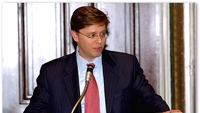FCC chairman announces green light for unlicensed white spaces use

On Oct. 15, FCC Chairman Kevin Martin proposed opening up unused portions of the TV airwaves known as white spaces for unlicensed devices to deliver wireless broadband service. The proposal, made in the wake of field tests, is a victory for the Wireless Innovation Alliance, a group of technology companies including Google, Phillips and Microsoft that have been pressing for unfettered access to the spectrum space being vacated after the switch to digital television Feb. 17.
The new frequency usage rules are expected to be issued on Election Day, Nov. 4, with an Oct. 27 deadline for interested parties to submit formal comments to the FCC. This is an unusually short comment period, especially considering the protracted time this issue has been under consideration. On Oct. 17, the NAB filed an emergency request that the agency seek a 70-day period for public comments, stating, “The report’s conclusions are not supported and in fact contradicted by the underlying data.” The filing also noted, “The FCC seems satisfied that white space devices will not significantly interfere with broadcast or cable TV signals in the home, a finding seemingly not well documented in its published test reports. At issue is the report’s contention that ‘proof of concept’ for the safe use of WSDs has been adequately proven in testing.”
While promising to consider the NAB request, the FCC seems satisfied that properly designed white space devices will not pose a significant interference threat. The FCC summary report states: “We are satisfied that spectrum sensing in combination with geolocation and database access techniques can be used to authorize equipment today under appropriate technical standards and that issues regarding future development and approval of any additional devices, including devices relying on sensing alone, can be addressed.” That summary specifies only white space devices operating from a fixed location being allowed into the spectrum with the transition to digital television. Portable white space devices and products that rely on spectrum sensing only remain under consideration, though it seems clear that the agency expects to approve them at a later date.
Google welcomed Commissioner Martin’s comments on the proposed ruling on the company's public policy blog. "This news should be greatly encouraging for American consumers," it said. "The FCC now has more than enough information to develop appropriate rules that protect TV stations and wireless microphone users from harmful interference while at the same time allowing innovators and entrepreneurs to develop technology that productively uses these airwaves."
Wireless microphone manufacturer Shure joined with the NAB in filing a request for a longer comment period (see Shure white space filing echoes broadcasters' call for public comment). Shure is a long-time proponent of using science to determine the best course for white space devices, and broadcasters, while still accommodating RF microphones as incumbent spectrum users, were not prepared to comment formally, because the reports issued to date do not specifically mention the fate of its products. “We are continuing to discuss matters with the commission, learning all we can about the planned ruling. Our goal is to make sure that wireless microphone users are adequately protected, now and after Feb. 17,” said Christopher Lyons, Shure’s manager of technical and educational communications.
There does appear to be a disparity between the positive test outcome noted in the FCC summary and actual test date found in the full Office of Engineering and Testing report on white space device field testing. The executive summary’s statement that the “proof of concept” had been met was particularly interesting insofar as it is the first time the FCC has used this language in referring to the purpose of white space device testing.
In addition, it appears that much of the unfavorable test data found in the field test summary report by the OET was downplayed or ignored. For instance, false-positive results from a Phillips prototype are credited as accurate scans, dramatically inflating the rated accuracy of that device. Even less favorable data from RF microphone testing is not published in full, but only summarized. Still, the report notes that, during testing at FedEx Field, one device found all channels occupied whether ESPN’s wireless mics were on or not, and another prototype “indicated several channels as available even when the microphones were on.”
The professional video industry's #1 source for news, trends and product and tech information. Sign up below.
As a result, it seems clear that the FCC’s pending white space device spectrum use rulemaking will be controversial as the agency attempts to balance the desire for expanded economic development in the technology sector and provide broadband wireless access to rural areas with the acknowledged need to ensure continued viability of broadcast TV, cable TV and wireless microphone systems.
For more information, visit www.fcc.gov.
